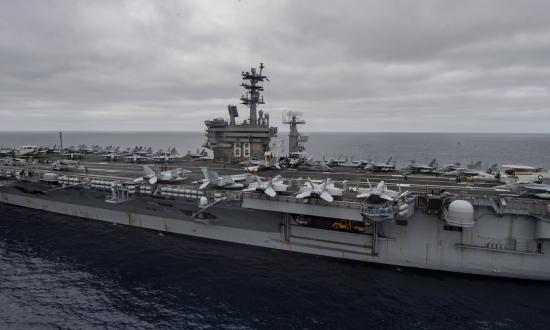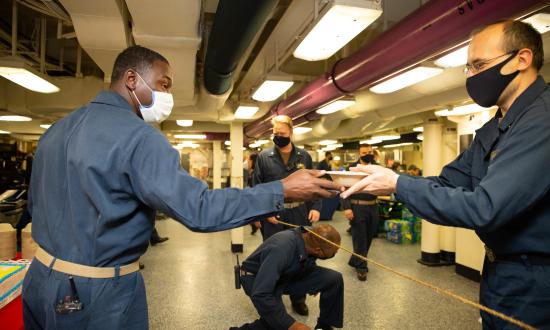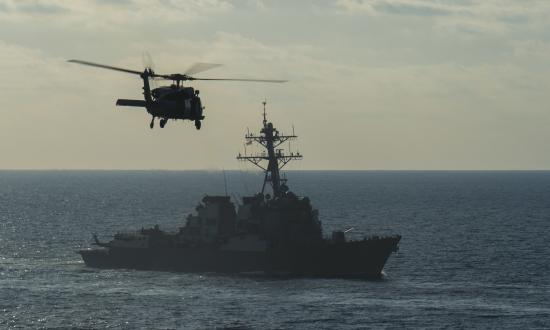As an operational commanding officer in the time of COVID-19, I found myself in uncharted waters. Across the table sat an engaging, intelligent, promising naval aviator—a junior officer who had earned his reputation as a “good stick” in the MH-60S Seahawk and an experienced air vehicle operator of the MQ-8B Fire Scout. A few days earlier, I would have pegged him as a future skipper. He is exactly the sort of high achiever that the U.S. Naval Academy recruits, trains, and graduates to “assume the highest levels of command, citizenship, and government.”1 Now, this promising officer was explaining why he wants to quit the Navy.
He credited several different, long-brewing motivations to stop flying and start the painful process of leaving the Navy. However, the preceding year’s restrictions on his individual liberty played a significant part in his desire to leave. On 23 June 2020, the Navy issued Fragmentary Order 20-024.012 implementing extensive personnel movement restrictions in response to COVID-19, known colloquially as the “Page 13 FRAGO” or “FRAGO-13,” because every sailor and officer was required to sign a form acknowledging receipt of the general order. The restrictions have remained almost entirely unaltered since implemented more than 10 months ago.
Besides significant questions regarding the restriction policy’s efficacy, fairness, and enforceability, the Page 13 FRAGO eliminated many of the normal outlets for stress relief that remained open to our civilian neighbors as well as sister service members. I can clearly see the results of those restrictions on the morale and mental health of my squadron, but more important, I am concerned that Navy personnel have already suffered significant and unnecessary damage to their long-term health.
The Page 13 FRAGO details specific rules for sailors’ behavior on and off duty while their installations maintain health protection condition charlie minus (HPCon Charlie Minus), the status for most of the past year at most bases in the United States. It limits “travel to/from place of residence/work with stops only for essential business (food, medical, pharmacy, gas, and childcare services).” Specific prohibitions on sailors during their personal liberty include visiting off-installation “swimming pools, gyms, fitness facilities . . . salons . . . tattoo parlors . . . and barber shops,” “participation in team/organized sports,” “dine-in restaurants (take-out authorized), bars, nightclubs . . . sporting events, concerts, public celebrations, parades, public beaches, amusement parks, (and) indoor religious services . . . non-essential commercial retail establishments and shopping malls.” Sailors were ordered to avoid “in-residence social gatherings that include more than 10 guests that do not reside the residence.” These rules went into effect shortly before the 4th of July and have remained intact ever since with one adjustment: As of 8 July 2020, members could attend indoor places of worship if they complied with the Center for Disease Control’s recommended precautions for communities of faith.
The Page 13 FRAGO applies to “all CONUS-based Echelon II commands, numbered fleet commands, type commands, region commands, and their subordinates.” Notably, it applies equally to sailors on sea duty and shore duty, and it does not apply to the OpNav Staff, Joint Staff, or sailors serving with other services (which have all continued to function without similar individual restrictions).6 This arbitrary application of restrictions yields some absurd outcomes, such as when officers are suddenly permitted to go to the beach when they transfer from a Navy billet to a joint billet on the same base.
The list of activities specifically prohibited by the FRAGO includes many of the normal, healthy outlets for sailors off base. Further, the disparity regarding the restrictions placed on sailors as compared with those on civilian neighbors causes unnecessary stress within Navy families—imagine a married couple confined to their home full of rambunctious children with no ability to reconnect on a date night for an entire year while their neighbors post pictures of their adventures to social media. COVID-19 is stressful enough and prohibiting many of the traditional options for managing that stress only hurts the force. Importantly, since the Navy is the only service to impose such severe restrictions—often in excess of local civilian restrictions—much of the blame justifiably falls on Navy leaders instead of on the COVID-19 virus itself. “Remember the FRAGO” could easily gain traction among the all-volunteer force if the economy improves and the Navy enters another period of poor retention.
COVID-19 remains a real threat, both to the health of sailors and to fleet readiness. However, it is far past time to update the Navy’s defensive posture, if for no other reason than to apply our improved understanding of the virus during the past year. A simple fix to the FRAGO would lean heavily on clear guidance from the Centers for Disease Control (CDC) as well as the significant local mitigations already enacted. The HPCon Charlie-minus requirement to limit travel outside of work/home to “essential business,” accompanied by the long list of specifically prohibited activities, could be reasonably updated to one simple order: “comply with CDC guidance.” Notably, the FRAGO’s requirement for the next lower HPCon level, Bravo, centers around guidance to “comply with health protection restrictions/measures established by local civil authorities” and therefore would not require significant modification.
Any additional restrictions on sailors’ liberty should be specifically targeted at those members who could reasonably find themselves on a ship or overseas base in the near future—deployable personnel on sea duty. From my perspective, that would apply to most of my command’s members. However, my immediate superior in command and his staff are on shore duty, mostly teleworking, and extremely unlikely to deploy during their current tours. Taking an even more extreme example, there are probably hundreds of sailors on a limited-duty status that have zero chance of deploying in the near future. These shore-duty and nondeployable personnel should be allowed to frequent their preferred hair salon, tattoo parlor, or CrossFit gym when local laws allow.
Finally, the Page 13 FRAGO was instituted before the Navy had many personnel with presumed immunity to the novel coronavirus. The Navy now has more than 200,000 sailors and officers with a significant level of immunity through vaccination or from recovering from COVID-19. Those personnel should not endure the same restrictions to protect them from a disease that no longer seriously threatens their health. Sailors with COVID-19 immunity should only be limited in their liberty and leave activities by local laws. This change could also help overcome resistance to voluntarily receiving the vaccine, hastening a return to normalcy and increased operational readiness.
I have sensed some resistance to making these recommended changes based on an assumption that sailors would act irresponsibly if the restrictions were lifted. This view grossly underestimates our shipmates while simultaneously minimizing the real sacrifices made by the all-volunteer force over the past year. Again and again, I have seen sailors make mature, risk-conscious decisions in the COVID-19 world—cancelling plans because someone at home has a sore throat, keeping their mask on even when not required, restricting social events to Zoom calls even after most participants have received the vaccine. As a commanding officer, I have approved countless leave requests to Pennsylvania, New Mexico, Georgia, etc., to see family, while receiving none to visit Las Vegas or the Florida beaches.
For me, playing team sports is my favorite stress-relieving activity. Yet, they are off limits. Likewise, a shipmate related that he loves to watch his kid play soccer but cannot because of the FRAGO. Recently, he drove several hours to his child’s tournament and then sat in his car while his wife watched the game. A Navy civilian employee in the same office made the same drive and was able to watch the tournament. This story is repeated countless times every weekend across the fleet. Even the “they just want to go to the bar” argument underestimates the impacts of the Page 13 FRAGO restrictions on younger, single sailors. Ordering them to pause their social lives for an entire year is unrealistic, unreasonable, and unfair. As one junior officer described it, “I have no work-life balance, it’s just work and not work.”
Perhaps the extensive restrictions in the FRAGO were necessary in June 2020 through this past winter, but times have changed. Very few people thought the pandemic would still haunt us a year after our society started shutting down, but our ability to assess and manage its risk has advanced significantly along the way. Relaxing the restrictions would yield several immediate benefits: The COVID mitigation measures would be based on up-to-date guidance from the nation’s health experts, sailors could return to the many stress-relieving activities they used to take for granted, and the voluntary vaccines would look even more attractive to a Navy population that remains skeptical of their utility. Perhaps it seems counterintuitive, but relaxing the FRAGO’s restrictions would thus result in a readiness increase. At the same time, these changes would stop the unnecessary damage to the force’s resilience as well as future Navy retention efforts.
I fear it may be too late to retain the talented lieutenant mentioned earlier in this article. My hope is that immediate, common sense modifications to the Page 13 FRAGO will prevent further damage while continuing to provide a ready force to man the fleet. Clearly, the FRAGO’s restrictions did not keep the virus out of crowded berthing areas, work centers, and cockpits. The Navy needs to adjust fire.
1. Reef Points, 1998 ed. (Annapolis, MD: Naval Institute Press, 1998), 20.






